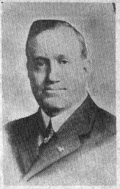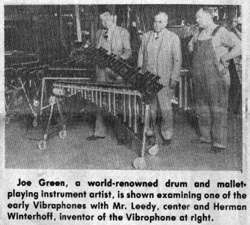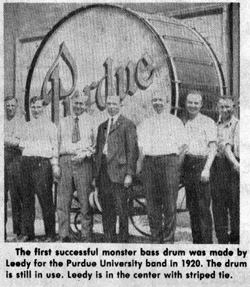October 1, 1981



Picture #1 – U.G. (Lester) Leedy
Picture #2 – Joe Green, a world-renowned drum and mallet playing instrument artist, is shown examining one of the early Vibraphones with Mr. Leedy, center and Herman Winterhoff, inventor of the Vibraphone at right.
Picture #3 – The first successful monster bass drum was made by Leedy for the Purdue University band in 1920. The drum is still in use. Leedy is in the center with striped tie.
Few Fostorians know that U.G. (Lester) Leedy, who became the organizer and president of the most famous drum manufacturing company in the world, lived in Fostoria when he was a boy. In fact, had it not been for his interest in drums and his continual beating of his first drum for his own amusement and others, his later career would probably not have developed.
Back in 1874, when Leedy was only seven, he bought his first drum from a Civil War drummer who lived near Fostoria. At that time the Leedy family home was at 602 S. Main St., just a block away from the Baltimore and Ohio Railroad station. Just about train time, the story goes, the seven-year-old drummer would sit on the front doorstep and beat his drum, which was almost as big as he. His drumming entertained the passersby, and many a penny or nickel was tossed his way.
A directory published in the 1970’s revealed that his father was I.B. Leedy, a carpenter, a fact which also contributed to Leedy’s success in the making of drums, as will be told later in this article. That same directory listed as a resident at 602 S. Main St as U.G. Leedy, painter. Whether he was the same Leedy, subject of this article is unknown. It would seem that Leedy, the drummer would have been quite young to be a painter, then.
PROFESSIONAL AT 14
By the time he was 14 years old, he had jointed the 15th Regimental Drum Corps, in Ohio and played with them as well as at numerous political campaign entertainments. By the time he was 18, he was a full-fledged member of the Fostoria town band and orchestra.
It was in the 80’s, while he was playing an Arbor Day engagement in Fostoria, in which he was billed for a xylophone solo with the band, that the business manager of Cedar Point happened to be in town. He heard the concert and a few days later wrote to Leedy and asked him to substitute in the Great Western Band, at that time one of the country’s leading band, which was to play at Cedar Point.
The young drummer was rather hesitant to take the job, as the drummer whose place he was taking was Max A. Wintrich, a fine drum artist who later was principal drummer in the Chicago Symphony Orchestra, for 32 years. However, he finally accepted the engagement and soon became a featured member of the band on drums and xylophone.
INVENTED DRUM STAND
Theatrical engagements rapidly followed, and Leedy did much traveling with minstrel shows, musical shows and circuses. From his travels and his many contacts with drummers, he decided that there was a great need for better drummers instruments.
He had been experiencing for some time with the construction of a stand to hold the snare drums, to get away from the unsatisfactory method of playing the drum on a chair. In 1890, while he was playing with a theater orchestra in Toledo, he finally invented and patented the first practical folding snare drum stand.
It was in the same year, 1890, that Leedy made his first drum. His father, the carpenter, mentioned earlier in this article, was also a skilled cabinet maker. He made and shaped the solid wood shells to his son’s specifications. Buying rods, heads and snare strainers from various manufacturers, Leedy assembled and sold his first snare drum.
MADE DRUMS AT HOME
Shortly afterwards, he accepted a theater position in Indianapolis, where he continued his sideline activity of making drums, getting the wood shells from his father still living in Fostoria, and assembling the drums in the basement of his Indianapolis home.
His position in the theater brought him into contact with many traveling drummers who became interested in the drums he made, and they placed orders with him. In time, orders for drums were coming from drummers all over the country, and the sideline business began to take up so much of his time and effort that Leedy decided to discontinue his theater work and devote his full time to making drummer’s instruments.
In 1895, he and Sam Cooley, a clarinet player in the same theater orchestra, each put $50 into the business and began the manufacture of Leedy drums under the from name Leedy Manufacturing Company. The first factory was a single room in the old Cyclorama Building in Indianapolis.
COMPANY PROSPERED
From the very first the new firm prospered, and soon Leedy drums were being shipped to all parts of the country. Other instruments were added to the line, and in 1902 Herman Winterhodd, an accomplished cello and trombone artist, who had also played in the theater orchestra with Leedy, joined the firm and took charge of the tuning of bells and xylophones.
The rapidly increasing demand for Leedy drummer’s instruments necessitated a move to larger quarters. Land was bought at the corner of Barth Avenue and Palmer in Indianapolis, and a one-story building was constructed to house the expanding business. Continued growth required more manufacturing space, until in 1927 the Leedy factory comprised 78,450 square feet in a modern 30-story structure in the original location.
CONN ACQUIRED IN 1929
In 1929 control of the Leedy company was acquired by C.G. Conn Ltd., and in 1930, the factory and personnel were moved to Elkhard, Ind. They continued ownership until the late 1950’s, at which time it together with the Ludwig Drum Co. was sold. The Singlerland Drum Co. purchased the Leedy name at that time. All of which goes to show that when a man like Leedy disposed of a personally build empire it often deteriorates.
When Leedy’s corporation was at its peak they furnished instruments for most of the great bands and orchestras, including the Army, Navy and Marine Bands.
One of their “Biggest” accomplishments was construction in 1920 of the first “monster”, bass drum for Purdue University’s marching band. It is still in use, and many readers many have seen it personally while attending football games, or on television.
The Leedy company also developed and built the vibraphone.
Trying to locate locally, possible descendants of the U.G. Leedy family. I struck a snag. Like the earlier Leedy’s, who lived at 602 S. Main St., there was also a Leedy family who lived on South Main not too far from that address. In fact, Kermit Leedy, one of the sons of the later Leedy’s in town still lives there.
Lynn Leedy of that same family lives west of town. Talking with both of them, I learned that as far as they know they had no other Leedy relatives who preceded them in Fostoria. However, according to Lynn, his father deceased, had often said that the Leedy’s were all related in some way.